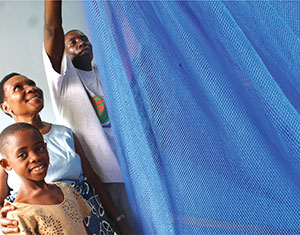In August 2008, the Government of Uganda signed the grant to purchase and distribute 17.7 million long-lasting ITNs over five years. In late 2008, the NMCP, PMI, and other malaria partners met to develop and resubmit an updated strategy to the Global Fund for approval.
In August 2008, the Government of Uganda signed the grant to purchase and distribute 17.7 million long-lasting ITNs over five years. In late 2008, the NMCP, PMI, and other malaria partners met to develop and resubmit an updated strategy to the Global Fund for approval. Macro-planning began in November 2009, to deal with the logistical challenges of receiving, storing, and then transporting the large quantity of nets arriving in the country. District-level micro-planning was no less challenging and consisted of 40 different tasks. Finally, in late 2009, a total of 7.2 million nets were procured and started arriving in-country in March 2010.
By the end of May, 1.4 million nets were distributed to pregnant women and children under the age of five in Central Region.
Distribution of an additional 5.8 million nets for the rest of the country was completed in December 2010. By that time, planning was already under way for a follow-up campaign to achieve universal coverage, so that all those at risk in Uganda will be protected against the threat of malaria.

